There are two possible variants of this aggression:
1. The most likely is an attack from the air against certain targets with the limited goal of their destruction;
2. Less likely, but still possible, is a direct invasion of the country. I think this variant would require a large number of forces, and this might deter the aggressor. In addition, world public opinion would greet such aggression with indignation.
Rest assured that we will firmly and decisively oppose any type of aggression. The morale of the Cuban people is extremely high, and they will meet the aggressor heroically.
Now I would like to express my strictly personal opinion on these events.
If the aggression takes the form of the second variant and the imperialists attack Cuba with the purpose of occupying it, the danger facing all of mankind…would be so great that the Soviet Union must in no circumstances permit the creation of conditions that would allow the imperialists to carry out a first atomic strike against the USSR.
I am saying this because I think that the aggressive nature of the imperialists has reached an extremely dangerous level.
If they carry out an attack on Cuba, a barbaric, illegal, and immoral act, then that would be the time to think about liquidating such a danger for ever through a legal right of self-defense. However harsh and terrible such a decision would be, there is no other way out, in my opinion.
The letter rambled on for another three paragraphs. It was signed: “with fraternal greetings, Fidel Castro.”
For the FKR cruise missile convoy that had been ordered to the launch position west of Guantanamo Naval Base, it was turning into a chaotic and disastrous night. The missile launchers and their support vehicles only had a dozen miles to travel, but the road was unpaved and bumpy, and ran alongside deep ravines. Shaken by the deaths of their two comrades, the drivers had to remain extremely vigilant to avoid another accident. It took the convoy another hour to reach the tiny village of Filipinas.
The launch position was in a clearing in the forest just beyond the village, next to a little stream. The terrain had already been prepared by field engineers, who had spent a week removing tree stumps and laying down gravel for the heavy vehicles. Antiaircraft guns guarded the approaches. The area was sealed off with barbed wire and guarded by Soviet troops. Cuban troops were responsible for the outer perimeter.
As the trucks approached a Cuban guard post a few hundred yards from the launch site, a nervous voice rang out through the darkness.
“Contrasena!”
The Russian soldiers at the front of the convoy shouted out the password. But there was evidently some mistake. Instead of allowing the trucks to proceed, the Cuban guards replied with a volley of rifle fire.
It took another hour, and a lot of swearing in Russian and Spanish, for the cruise missile unit to sort out the confusion over the password. One of the Soviet officers, who spoke pigeon Spanish, eventually managed to communicate with the trigger-happy Cubans. The convoy of trucks, jeeps, and electronic vans rumbled into the cleared field next to the stream.
“Razvernut’sya!” ordered Major Denischenko. (“Deploy!”)
The trucks moved into position around the launch site. The nuclear-armed cruise missiles sat on their transport trailers, resting on long metal rails. They looked like large model airplanes, about twenty-five feet long, with a twenty-foot wingspan. Electronic vans were parked nearby. If the order was given to fire, a solid-fuel rocket would propel the snub-nosed missile off the rails into the air. Twenty-five seconds later, a jet engine would take over. The radio operator would guide the missile to its target from his post in one of the electronic vans. The missile would cover the fifteen-mile distance to the American naval base in less than two minutes, screaming over the rock-strewn landscape at a height of around two thousand feet. When it was above the target, the operators would give another signal, switching off the engine and sending the missile into a dive. The nuclear warhead was programmed to explode a few hundred feet above the ground, to cause maximum destruction.
A launch team consisted of an officer and five enlisted men: a senior aviation mechanic, two electricians, a radio operator, and a driver. Once the missile had been deployed to the start position, the remaining preparations took about an hour. In theory, the missiles could only be fired on orders from the regimental commander, Colonel Maltsev, who would only act on instructions from Moscow. As a practical matter, however, the lack of codes or locks on the warheads meant that they could be launched by a lieutenant, with the help of a couple of soldiers.
“Okopat’sya!” yelled the major. (“Entrench!”)
There was not much point to this order. The ground was so hard and stony that it was impossible to dig down below the topsoil. The officers eventually relented. They permitted the troops to pitch their tents on the rocks and rest for a couple of hours. In the meantime, everything was in place for the nuclear destruction of the Guantanamo Naval Base.
Inside the naval base, American electronic eavesdroppers followed the Soviet convoy as it moved toward Filipinas, experiencing a fatal accident along the way. Thanks to the emergency radio transmissions, they were able to identify both military camps, as well as Maltsev’s field headquarters. All three locations were marked down for U.S. air attack under Operation Scabbards. Intelligence officers reported large numbers of “Russ/Sino/Cuban troops,” moving “unidentified artillery equipment” to Filipinas. They noted that the complex was “mobile and requires constant surveillance.”
Precisely what kind of “equipment” the Soviets had placed in Filipinas remained a mystery to U.S. intelligence analysts. It never occurred to them that the naval base had been targeted with tactical nuclear weapons. When the British consul in Santiago de Cuba passed on rumors about Soviet rocket launchers in Filipinas, he was thanked for the information by his superiors and told not to worry. “The U.S. authorities in Guantanamo know of base in [Filipinas] and are not interested, as rockets are small guided missiles not carrying atomic warheads.”

Close-up of missile launch position, Sagua la Grande. [ NARA ]
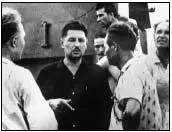
General Igor Statsenko, commander of Soviet missile troops on Cuba. [ MAVI ]
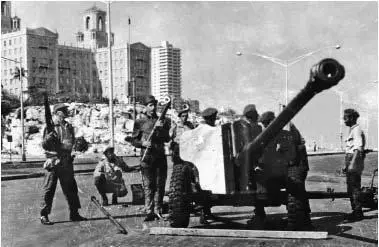
A Cuban antiaircraft battery took up position outside the Hotel Nacional on the Malecon in Havana. [ Cuban government photo made available at the 2002 Havana Conference ]
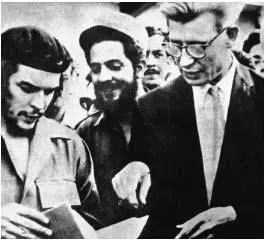
Che Guevara (left) with Soviet ambassador to Cuba Aleksandr Alekseev (right). Before being appointed ambassador, Alekseev was a KGB agent who made the first formal Soviet contact with the leaders of the Cuban revolution. [ MAVI ]
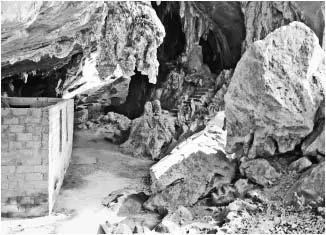
The cave in the mountains above the San Cristobal missile sites that was used by Che Guevara as his headquarters during the missile crisis. Cuban soldiers built a concrete structure inside the cave to provide Che with some privacy. It is now preserved as a shrine to Che. [ Photo by author ]
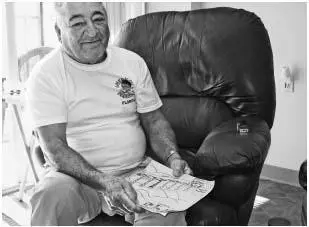
Pedro Vera at his home in Tampa in 2006. Vera is holding a copy of a plan of the Matahambre aerial tramway he attempted to sabotage in October 1962. [ Photo by author ]

This previously unpublished U.S. Navy reconnaissance photo of the Matahambre area from Blue Moon Mission 5035 on November 2 shows that the CIA sabotage mission has failed. The copper mine and aerial tramway are both intact. [ NARA ]
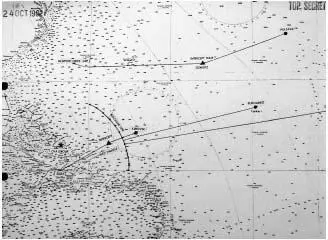
Top secret U.S. Navy map of the planned interception of the Kimovsk and the Poltava on October 24. The Soviet missile-carrying ships were already on their way back to the Soviet Union. The Navy permitted the oil tanker Bucharest to proceed to Havana. [ USNHC ]
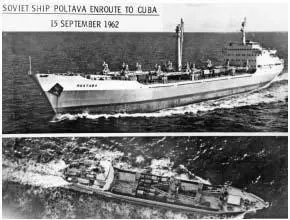
The Poltava photographed in September 1962 while transporting eight R-12 missiles to Cuba for one of the San Cristobal missile sites. She started a second run in October, with seven R-14 missiles on board, but turned back to the Soviet Union on October 23 following President Kennedy’s declaration of a naval quarantine. [ NARA ]
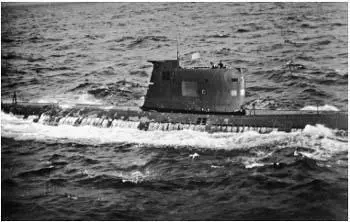
Soviet submarine B-59 under the command of Valentin Savitsky was forced to the surface by the U.S. Navy on “Black Saturday,” October 27. The submarine is flying the red flag. Crew members in the conning tower are observing a U.S. reconnaissance plane overhead. [ NARA ]
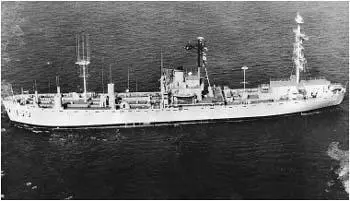
The USS Oxford was stationed off Havana during the crisis to scoop up Soviet and Cuban communications, including radar and microwave signals, from tall masts fore and aft. [ USNHC ]
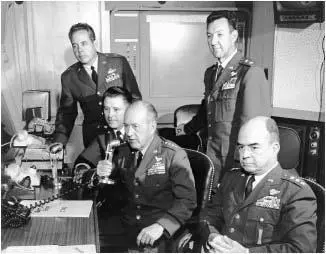
General Thomas Power, surrounded by his staff in his command post at Offutt Air Force Base, Nebraska, broadcasts the DEFCON-2 order to the Strategic Air Command on October 24. [ U.S. Air Force ]

Fifty feet under Montana prairie, the two-person Minuteman missile combat crew is on strategic alert. Technicians jerry-rigged the launch system to allow the Minuteman to be fired from a single command center rather than two command centers, as required by safety regulations. [ U.S. Air Force ]
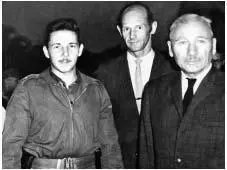
The commander of all 43,000 Soviet troops on Cuba, General Issa Pliyev (right), with Cuban defense minister Raul Castro (left). A former cavalry officer, Pliyev had little understanding of missile systems but was trusted by Khrushchev, who had ordered him to suppress food riots in southern Russia in June 1962. [ MAVI ]
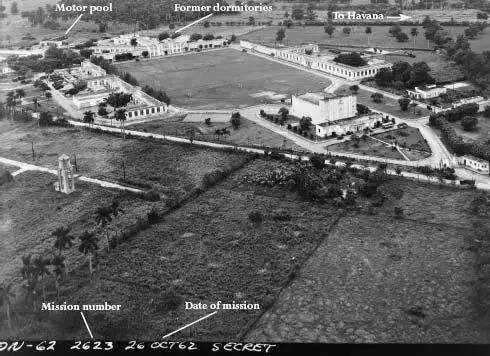
Previously unpublished U.S. reconnaissance photograph of Soviet military headquarters at El Chico, southwest of Havana, taken by Air Force RF-101s on Blue Moon Mission 2623 on October 26. The Americans knew the site by the nearby villages of Torrens and Lourdes. Prior to the revolution the campus had served as a boys’ reform school. [ NARA ]

Lt. Gerald Coffee (left) and Lt. Arthur Day (right) being debriefed by Rear Admiral Joseph M. Carson, commander of Fleet Air Jacksonville, immediately after returning from a mission over Cuba. Coffee and Day both came under Cuban antiaircraft fire on October 27. Coffee photographed nuclear capable FROG/Luna missiles on October 25. [ USNHC ]
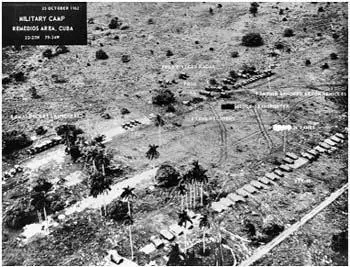
Photograph of nuclear capable FROG/Luna missiles near Remedios, taken by Lt. Coffee on Blue Moon Mission 5012 on October 25. As a result of this photograph, U.S. estimates of Soviet troops on Cuba rose sharply. President Kennedy was briefed about the photograph on the morning of October 26. [ NARA ]
Читать дальше





























